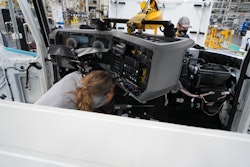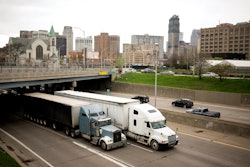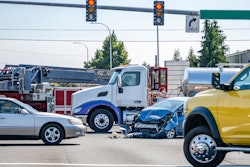An article that appeared in the April 8 edition of CCJ in the Business, Workforce Development section entitled “Study Reveals Driver Fatigue and Mental Heath Struggles” caught my attention and angered me almost to a stroke level.
CCJ needs to do a little fact checking before it regurgitates a vile, vicious, and vilifying portrayal of the trucking industry, its companies and its drivers in print.
The article took down several libelous factoids and misrepresentations that cannot in good conscience go unchallenged.
We can all agree on one central theme and that is the job of a professional CDL holder in full-truckload, long-haul trucking is a very difficult one. It is lonely, mentally and physically demanding, and requires special people to carry it out safely.
Our industry is quite proud of our drivers – our heroes of the road – who literally save hundreds of lives and avoid hundreds of accidents every week despite the irresponsible, careless and reckless behaviors of the driving public with whom they share the road.
When there is a car/truck crash the fault is not with the truck but with the auto in 84% of those accidents. Billboard ambulance chasers like Gruber Law ignored this inconvenient truth and provided to CCJ an internal study from 2019 to 2023 (during the COVID years) where they produced a series of big lies that are not supported by any statistical information. Let’s peel back the onion so to speak and look at some of these.
What is a big lie? It is really a psychological concept that basically says that an undocumented statement that is repeated over and over again by a reliable source is eventually perceived as being true, regardless of how absurd it might be at the outset. There are many examples of the big lie in history, but the most famous was the series of lies told by Hitler’s regime to the German people concerning their Jewish population.
CCJ echoes several big lies in the article in question:
• The very beginning of the article where it is stated, “Truck drivers are struggling with extreme fatigue, isolation and high rates of depression leading many to self-medicate with alcohol and stimulants to keep working.”
The report, according to Gruber Law, utilized data from the Federal Motor Carrier Safety Administration, Centers for Disease Control and Prevention, The National Institute for Occupational Safety and Health, Substance Abuse and Mental Health Services Administration, American Addition Centers, RPM Moves, and peer-reviewed research along with 3,000 long-haul and regional drivers from 2019 to 2023 (during the height of COVID). Though these creditable sources are supposedly attached to the data, there are no direct quotes, footnotes, or any traceable evidence of what these studies showed.
• The big lie that I’m quite familiar with is the one concerning lack of sleep. The report referenced in the article states that “nearly half of truck drivers sleep less than six hours a night.” She then extrapolates that to “sleeping fewer than five hours results in a tripling of the crash risk and that the report (by Gruber) avers that fatigue of this sleep level is equivalent to 0.08 blood alcohol concentration (BAC) impairment.”
The idea that crash risk triples with less than five hours of sleep is totally made up and probably comes from the FMCSA’s rationalization that driver fatigue went up exponentially as the shift time increased from hour one to hour 13. The agency used “relative risk” theory that was discredited and debunked as statistically absurd when it was pointed out that the relative risk increase was based on the theory that the likelihood of a crash went from six chances in hour five to 13 chances in hour 13, which they erroneously reported as doubling the likelihood of an accident. This is not only disingenuous, it is statistically unsupportable to state that six chances in 1,500,000 and 13 chances in 1,500,000 would result in over a more than 100% increase in the relative risk. Ergo, relative risk did not apply. Actually, that study discovered that the first hour in a shift was statistically the most dangerous hour although there is little or no fatigue at that time.
• As far as the idea that sleeping five hours or less is criteria for a sleep deficit is also totally made up and unsupportable. Col. Belenky, who studied battle fatigue for over 20 years, told us in 1999 at a driver fatigue symposium that nothing he had uncovered in his 20 years of research indicated to him that a one-hour nap was not as restorative as a full night’s sleep. I suppose that this reinventing of the truth came as a result of the big lie told at that very symposium when Joan Claybrook stated that 65% of America’s truck drivers had obstructive sleep apnea and that was equal to or worse than driving drunk.
That irresponsible hyperbole has been repeated over and over inside the beltway and in the halls of Congress. Most of the unproductive, unnecessary and, in some cases, dangerous elements of hours of service and driver health has been erroneously built around that double lie. Sleep apnea, or hypopnea, is perfectly normal in all humans. As mammals, we all stop breathing while asleep. Unless there is chronic daily drowsiness associated that results in a severe sleep deficit or narcolepsy, there is no fatigue risk with apnea. And, if there were, why was STOP-BANG protocol not mandatory for all safety sensitive jobs that would include doctors serving their residencies, governmental agency employees, and Congress?
To my knowledge obstructive sleep apnea has never been cited as the primary cause of a car/truck accident. Fatigue, however, is a contributory factor in all accidents, whether on the highway, in the home or in the office, and each of us is responsible for managing our own fatigue, not FMCSA, Gruber Law, or a trucking company owner.
• The most egregious misrepresentation of fact comes with Gruber Law’s assertion that, “alcohol and amphetamine use is also high at 91% and 82.5%, respectively. Drivers are abusing substances to self-medicate untreated mental health issues.”
Where does this come from?
Without going into how large this misrepresentation truly is, I will point out prior to bringing on mandated alcohol testing for truck drivers, the government did a two-year study in four states and performed 66,000 random roadside tests for alcohol. They had eight positives at the 0.08 BAC level proving, at least for me, that long-haul professions do not drive impaired.
The insignificant results did not deter FMCSA from including random alcohol testing and that remains a rule that forces the smallest of companies to perform these tests. NASTC administers the drug and alcohol program for 5,000 trucking companies. We have over 8,000 drivers in our consortium, and over the last 30 years you can count the number of positives for alcohol on one hand.
This supposed study by Gruber Law has since publication been taken down and CCJ has agreed to publish my rebuttal based on more responsible facts. However, this serves as an ugly reminder of how badly we need to oppose these types of self-serving attacks to our industry by entities like Gruber Law and loudly begs for someone to do something about tort reform and the proliferation of so-called nuclear verdicts in our industry.
David Owen cofounded and serves as President of the National Association of Small Trucking Companies. Access information about NASTC's many services to owner-operator and small fleet members via its website, nastc.com.














